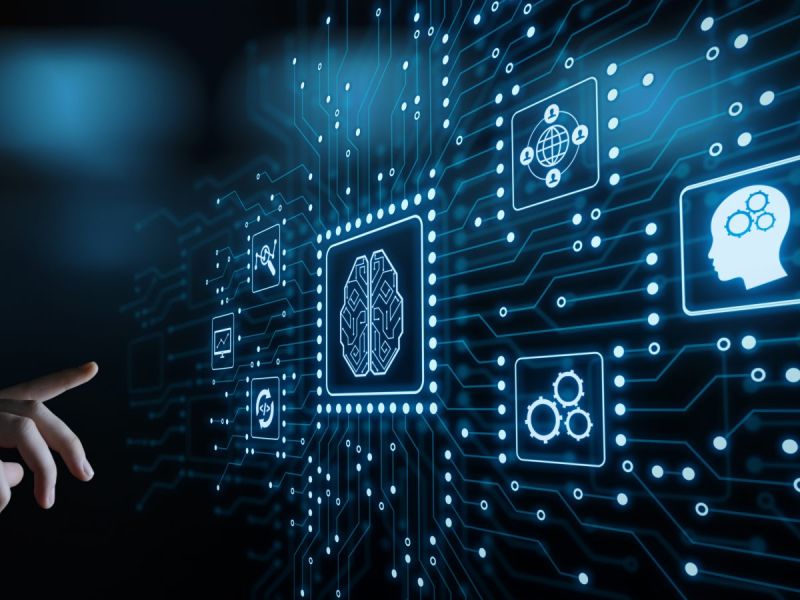From IBM’s Quantum System 2 to net zero data centres, and many more. As the global technological landscape witnesses significantly shifting paradigms, we take a look at the top technology trends of 2023; those that lay the foundations of breakthroughs in 2024.

Technology is evolving at the velocity of light, pushing boundaries and reshaping industries in the blink of an eye. The rapid advancements across various sectors, from quantum computing to smart city technologies, Web 3.0 and metaverse technologies, and green technologies.
This accelerated velocity not only challenges the status quo but also demands an agile and an open-minded approach from individuals and organisations, so as to harness the full potential of the swiftly advancing technological frontiers.
Here are the top 13 top tech trends in 2023 that are going to shape the future of humanity in 2024.
1. Blockchain and Web 3.0 in 2023
In 2023, the blockchain technology evolved beyond its application in cryptocurrencies. Collaboration between established financial institutions and DeFi projects, cross-chain compatibility to ensure interoperability, and decentralised exchanges have been some of the emerging trends during the year.
Continuous innovation in liquidity mining and yield farming strategies provided participants with diverse and sustainable yield opportunities, while the rise of Decentralized Autonomous Organizations (DAOs) brought transparency and decentralisation to governance structures.
Amidst these advancements, the DeFi space placed a heightened emphasis on smart contract auditing and security measures, reflecting a commitment to bolstering platform resilience and addressing growing security concerns.
2. Quantum Computing tech trends
In 2023, notable progress unfolded in the field of quantum computing. During its annual Quantum Summit, IBM introduced its latest ‘Heron’ processor, featuring an architecture meticulously designed to achieve IBM’s peak performance metrics and the lowest error rates among all IBM Quantum processors thus far.
The company also unveiled its 1,121-qubit quantum chip, Condor, in December 2023, based on its cross-resonance gate technology. Condor pushes the limits of scale and yield in chip design with a 50% increase in qubit density, advances in qubit fabrication and laminate size, and includes over a mile of high-density cryogenic flex IO wiring within a single dilution refigerator. With performance comparable to our previous 433-qubit Osprey, it serves as an innovation milestone, solving scale and informing future hardware design.
3. Advanced robotics and automation
In 2023, the field of advanced robotics witnessed a groundbreaking wave of innovation marked by the seamless integration of artificial intelligence (AI) into robotic systems, characterised by adaptive learning algorithms that enabled robots to dynamically evolve and enhance their capabilities through experience.
Human-robot collaboration reached new heights as biomechanics revolutionised robotics with bio-inspired limb mechanisms, allowing for more natural and efficient movements. Sensory feedback systems further elevated the human-robot interaction, providing robots with a heightened awareness of their surroundings. Swarm robotics took center stage, unleashing collaborative task execution among a collective of robots, while decentralized decision-making empowered these robotic systems with increased autonomy and efficiency. These innovations collectively propelled advanced robotics into a new era, where AI-driven adaptability, biomechanical advancements, and collaborative capabilities reshaped the possibilities and applications of robotic technology.
Amazon revealed the commencement of testing for Digit, a bipedal robot capable of grasping and lifting items, developed through a collaboration with Agility Robotics. The initial application of this innovative device will involve the handling of empty tote boxes, streamlining the ‘highly repetitive’ processes within Amazon’s operations. The introduction of Digit is part of Amazon’s continued efforts in integrating robotics technology into its facilities, a journey that began in 2012. Despite the implementation of robotics, Amazon asserts that it has contributed to the creation of hundreds of thousands of jobs globally.
4. Sustainable and green technologies
The increasing demand for data center capacity, driven by exponential growth in AI, cloud computing, and other technologies, is prompting the exploration of innovative solutions to achieve net-zero-energy data centers.
As highlighted in The World Economic Forum‘s ‘Top 10 Emerging Technologies of 2023’ report, various strategies are emerging to realize this goal. Among them is the adoption of water or dielectric liquid cooling systems to efficiently dissipate heat. Additionally, AI-enabled systems play a crucial role in this endeavor by analysing and optimising energy usage in real-time, leading to a significant reduction in energy consumption.
For instance, Google‘s data centers have experienced up to a 40% decrease in energy consumption through the implementation of these advanced, energy-efficient practices.
5. Hyperautomation
Coined by Gartner in 2020, hyperautomation represents a systematic and business-driven strategy adopted by organisations to swiftly identify, assess, and automate a multitude of business and IT processes.
According to UiPath, a prominent RPA software company, hyperautomation involves the integration of various components of process automation, combining tools and technologies to enhance the capacity for work automation.
“The rise of generative AI is a very exciting development in the world of automation, as generative AI and automation can work together to unlock revolutionary benefits for businesses.” – Boris Krumrey, Global VP of Automation Innovations.
6. Generative AI
The year marked unprecedented growth in this domain, with significant contributions such as the release of PyTorch 2.0, setting a new industry standard and empowering researchers and developers with robust tools.
Enhancements to Nvidia‘s Modulus and Colossal-AI’s PyTorch-based framework further enriched the open-source ecosystem, fostering collaborative innovation, with major players like Microsoft and Google making noteworthy contributions, such as Microsoft integrating ChatGPT into Bing and Google unveiling Bard.
However, controversies arose, notably with Meta‘s release of Llama 2 as “open source,” sparking debates about the definition of openness in AI and prompting discussions on the need to redefine licensing models for the unique challenges posed by AI technologies.
Concurrently, the year saw the emergence of advanced generative AI models, exemplified by OpenAI‘s GPT-4, which redefined language capabilities with proficiency in creative writing, coding, and complex problem-solving. Models like Jina AI’s 8K Text Embedding Model and Mistral AI’s Mistral 7B showcased the community’s growing expertise in handling vast textual data, indicating a trend toward more powerful and versatile AI models applicable across various domains.
The year also saw the formalisation of EU AI Act, the world’s first extensive legislation on AI by the European Union. IBM recently created a GPT tool to assist in evaluating projects for compliance with the EU AI Act.
7. Multicloud technology in 2023
Approximately 90% of organisations, have embraced a multi-cloud environment, taking advantage of the flexibility to customise their cloud solutions. However, this shift in managing workloads necessitates an equally evolved security approach.
While a do-it-yourself (DIY) approach may appear cost-effective initially, it can pose challenges for security teams, including the complexity of implementing a cross-cloud security policy, increased costs, and the potential risk of misconfiguration that may compromise data security.
As indicated by research conducted by SAS, contemporary organisations are actively engaged in operations spanning three private clouds, with an additional 42% utilising a minimum of two public cloud providers for critical business functions, analytics, and hosting essential data.
During its Explore 2023 event in Barcelona, VMware highlighted its commitment to aiding organizations in the adoption of a ‘Cloud Smart’ approach. This strategic initiative aims to effectively navigate the complexities associated with multi-cloud environments, transforming them into a source of competitive advantage for businesses.
8. Metaverse and immersive technologies in 2023
Augmented and virtual reality technologies hold the potential to dissolve the boundaries between the physical and digital realms, paving the way for novel opportunities in interaction and learning.
The highly anticipated entry of Apple into this domain with its Vision Pro headset has been hailed by CEO Tim Cook as the ‘beginning of a new era for computing.’ The product is poised to revolutionize the spatial computing sector, offering innovative possibilities for users. Apple’s venture into this space is anticipated to act as a catalyst, potentially accelerating the growth of the metaverse.
According to a Bloomberg report, the metaverse market may reach a valuation of US$615 billion by the year 2030.
9. Innovations in Zero trust technologies in 2023
“Zero trust will become the default end state people are moving towards. It’s the right answer on how to change the curve on cyber.” – John Roese, Global CTO of Dell Technologies
The overarching concept of Zero Trust revolves around minimising implicit trust across the entire enterprise. The objective is to transition an organisation from an outdated, non-defensible architecture reliant on compliance, controls, and a static protection-oriented mindset to a defensible security architecture. This new framework is rooted in continuous, dynamic, threat-informed defense and risk-based adaptive trust, emphasising a proactive and adaptive approach to security.
According to a Cisco report, globally, 90% of organisations have initiated the adoption of zero-trust security measures.
10. Innovation trends in 6G: Connectivity beyond 5G
The deployment of 5G networks has rapidly progressed in 2023, delivering unprecedented speeds and connectivity. Companies like Nokia and T-Mobile are harnessing its full potential to drive advancements.
Simultaneously, exploration into 6G, the upcoming generation of networks, has commenced, promising even more transformative innovations in wireless technology. Anticipated to revolutionize industries, economies, and society at large, 6G networks are poised to empower the Internet of Things ecosystem and facilitate seamless integration with AI and immersive technologies.
According to a report from the 5G Infrastructure Association, 6G is expected to usher in ‘near-instant and unrestricted complete wireless connectivity,’ fundamentally reshaping the operational landscape for enterprises.
11. 3D printing and additive manufacturing
GE Aerospace has embarked on a journey with metal additive manufacturing, steadily advancing application by application. Renishaw, in collaboration with partners Evo 3D and Rolls-Royce, engaged in a groundbreaking £1.1 million 3D printing project, supported by Innovate UK, while concurrently contributing to the production of the innovative Hope-Lotus track bike for Team GB athletes.
Toyota, under the guidance of Dallas Martin, played a significant role in the development of Stratasys’ latest Fused Deposition Modelling machine, with Toyota poised to become its inaugural customer. These initiatives underscore the dynamic progress and cross-industry collaborations within the ever-evolving landscape of 3D printing and additive manufacturing.
12. Genomics
In 2023, genomics saw a surge in transformative trends, encompassing advancements in Next Generation Sequencing (NGS) technologies, enabling faster and more comprehensive genomic analysis.
Genome data analysis reached new heights with sophisticated tools and techniques, enhancing our understanding of genetic information. Genome editing continued to evolve, offering increasingly precise and efficient methods for modifying genetic material. Artificial Intelligence played a pivotal role in genomics, revolutionising data interpretation and uncovering complex patterns within genomic datasets.
Functional genomics expanded its impact, providing insights into gene functions and interactions. Metagenomics gained prominence, allowing the study of genetic material from entire microbial communities. Single-cell genomics offered unprecedented resolution in understanding individual cell characteristics.
Lastly, the exploration of 3D genomics provided insights into the spatial organisation of genetic material, collectively shaping the landscape of genomics in 2023.
13. Smart homes and cities
Smart mobility has become a cornerstone, emphasizing efficient and sustainable transportation solutions. Digital citizenship has gained prominence, leveraging technology to enhance citizen engagement and services. Public safety and security have seen advancements through innovative technologies, ensuring a secure urban environment. The integration of smart energy solutions has become pivotal in promoting sustainability and resource efficiency.
E-governance has evolved, leveraging digital platforms for streamlined and accessible public services. Green urban planning has emerged as a key trend, emphasising environmentally conscious infrastructure development.
Advanced waste management systems contribute to creating cleaner and more sustainable urban environments. Smart buildings are incorporating cutting-edge technologies for enhanced efficiency and resource utilisation. Advanced water management initiatives aim to address water scarcity through intelligent solutions.
Finally, intelligent farming practices underscore the integration of technology in agriculture to promote sustainable and resource-efficient food production within the framework of smart cities.

With a driving passion to create a relatable content, Pallavi progressed from writing as a freelancer to full-time professional. Science, innovation, technology, economics are very few (but not limiting) fields she zealous about. Reading, writing, and teaching are the other activities she loves to get involved beyond content writing for intelligenthq.com, citiesabc.com, and openbusinesscouncil.org




























